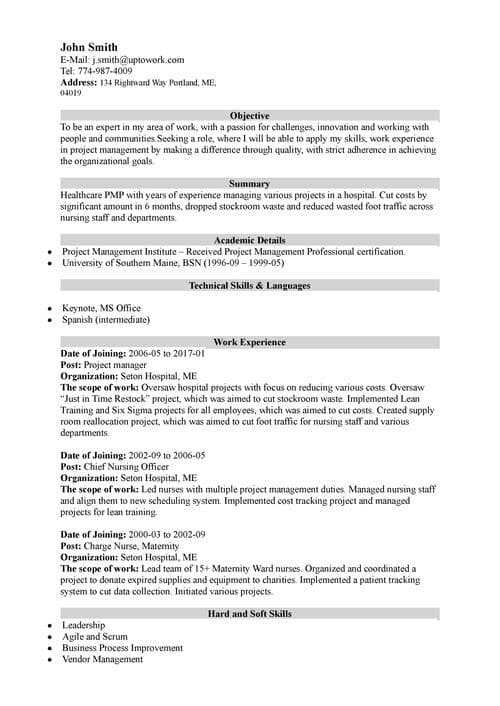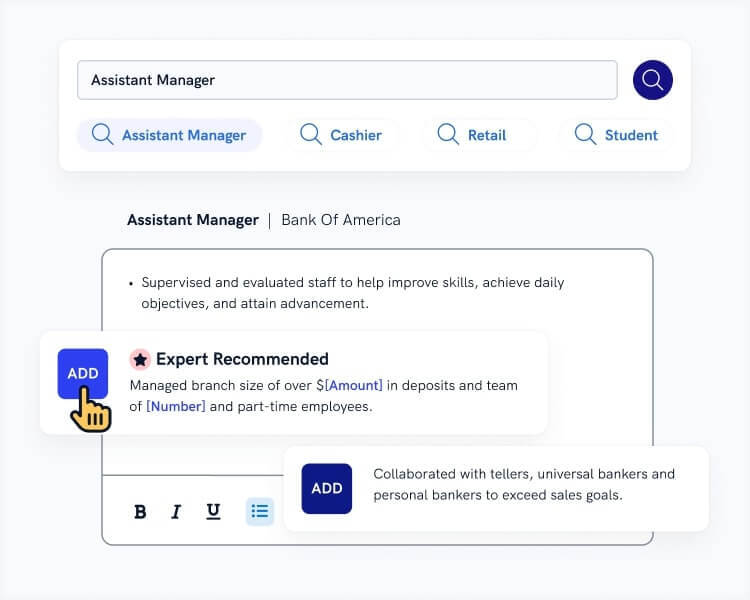Think of your resume like a toolbox—it holds everything an employer needs to see what you can do. From your work history to your skills, each part has a job to do.
In this article, we’ll break down each section of the resume and show you tips to build one that’s clear, strong, and ready to impress. Whether you’re just starting or updating your old application, these resume tips and tricks will help you feel confident and prepared.
Want to save time and have your resume ready in 5 minutes? Try our resume builder. It’s fast and easy to use. Plus, you’ll get ready-made content to add with one click. Explore our free resume templates and start building your resume today.
Sample resume made with our builder—See more resume samples here.
Before you dive deeper, look at the video created by our career expert Caio on resume tips:
Resume Formatting Tips
1. Choose a resume format that works for you
Importance: ⭐⭐⭐⭐⭐
Your resume format organizes your sections to show your strengths first. There are three types of resume formats. Pick one based on your experience level:
- Chronological resume: The most common resume format, it puts your work experience front and center to show your career growth.
- Functional resume: Focuses on skills instead of job history, which makes it great for recent graduates and career changers.
- Combination resume: It highlights both skills and experience, making it a strong choice for mid-level professionals.
2. Stick to traditional fonts
Importance: ⭐⭐⭐⭐
You may think resume fonts are trivial in the larger scheme of things, but the right font will do a lot for your resume. A professional and easily readable one will make your resume look polished. Stick with Arial, Calibri, or Times New Roman and keep the font size between 10-12 points.
3. Keep your margins consistent
Importance: ⭐⭐⭐
Resume margins do more than you think. That’s because resumes with text-crammed edges look messy and unprofessional. If you need more space on your resume, it’s okay to drop your bottom and top margins to 0.5” and your side margins to 0.75”—but not less.
4. Maximize whitespace
Importance: ⭐⭐⭐
An effective resume is easy to skim. Balance your text and white space to help recruiters read it faster while enhancing its aesthetic as well.
5. Make your resume ATS-friendly
Importance: ⭐⭐⭐⭐⭐
Most companies use applicant tracking systems to filter applications. That’s why creating a resume that passes ATS must be a priority. Avoid overcomplicated designs, tables, and text boxes. Use standard section headings like "Resume Summary" and "Work Experience" to keep your resume ATS-friendly.
6. Use a professionally designed template
Importance: ⭐⭐⭐⭐
Professional resume templates check all the boxes to make sure your resume is top-notch. Plus, it saves you time and effort that you can redirect to applying for more jobs!
Tips for Resume Contact Information
7. Make sure your contact details are up to date
Importance: ⭐⭐⭐⭐⭐
Double-check that your phone number, email, and address are correct. You don’t want to miss an interview because you put the wrong phone number on your resume header.
8. Include links to your professional website or portfolio
Importance: ⭐⭐
If you have a professional website or digital portfolio, include the URL in your contact section. Most professionals include their LinkedIn profile in their resume. Take an extra few minutes to make sure your URLs are live and hyperlink them in the text so they are accessible.
Resume Summary & Objective Tips
9. Lead with your strengths
Importance: ⭐⭐⭐⭐⭐
Recruiters only spend a few seconds scanning each resume. Start strong by showing the skills and experience they’re looking for. Read the job description for keywords, then write a resume summary or objective that highlights your most relevant qualifications.
Both resume summaries and objectives go at the top of your resume. These short introductions help employers quickly see why you’re a great match for the job.
10. Know when to use a resume summary vs a resume objective
Importance: ⭐⭐⭐⭐
Resume summaries and objectives highlight your top qualities, but the right one depends on your experience and goals.
- Use a resume summary if you have at least five years of work experience and want to show your career growth and key accomplishments.
- Use a resume objective if you’re just starting out or changing careers and want to focus on your skills and goals.
11. Keep it short and focused
Importance: ⭐⭐⭐⭐
Whether you choose a summary or objective, aim for three to four short sentences. Focus on your most relevant skills, experience, or goals for the role. Avoid buzzwords or filler—use this space to show why you're a great fit, right from the start.
Check out this example for a resume summary:
Creative and detail-oriented graphic designer with seven years of experience developing visual content for print, digital, and social media campaigns. Skilled in Adobe Creative Suite, branding, and layout design. Known for turning complex ideas into clean, eye-catching visuals that support marketing goals. Recently led a website redesign project that increased user engagement by 35%.
Work Experience Writing Tips
12. List jobs in reverse-chronological order
Importance: ⭐⭐⭐⭐⭐
Start with your most recent job and work your way backward. This order helps employers see your most current work experience first, which is usually the most relevant. Include the job title, company name, location, and dates you worked there.
13. Use bullet points
Importance: ⭐⭐⭐
Bullet points make your experience easy to read. Under each job, list a few key job duties and accomplishments. Focus on what you did and how it helped your team, customers, or company.
14. Start with action verbs
Importance: ⭐⭐⭐
Begin each bullet point with a strong action verb like led, created, organized, or improved. These words show that you took action and made a difference in your role.
15. Highlight results
Importance: ⭐⭐⭐⭐
Try to include numbers or percentages to underline your success. For example: “Trained five new employees” or “Boosted customer satisfaction scores by 15%.” These examples help employers see the real impact of your work.
Tips for Resume Skills
16. Focus on relevant skills
Importance: ⭐⭐⭐⭐⭐
Include skills that match the job you’re applying for. Read the job description and pick the ones that show you’re a good fit. This strategy helps your resume pass applicant tracking systems (ATS) and stand out to hiring managers.
17. Mix hard and soft skills
Importance: ⭐⭐⭐⭐
For a well-rounded view of what you bring to the table, mix hard and soft skills. Choose six to eight skills that balance your ability to work in a team with specific abilities related to the role.
18. Elevate your section with technical skills
Importance: ⭐⭐
Technical skills are a great way to show you master software or tools directly related to the role. For example, if you're a graphic designer, some technical skills to include would be:
- Adobe Illustrator
- Figma
- Web design (HTML/CSS)
- Prototyping and wireframing
- Premier Pro
Education Section Writing Tips
19. Include your highest degree
Importance: ⭐⭐⭐⭐⭐
In your education section, start with your most recent or highest level completed. Include your degree or diploma, school name, and graduation year. If you're still in school, you can add your expected graduation date.
20. Add extra details when needed
Importance: ⭐⭐
If you’re early in your career or don’t have much work experience yet, you can include relevant coursework, honors, or academic projects. These details can show your knowledge and interest in the field.
Finishing Touches
21. Consider including optional sections
Importance: ⭐⭐
If you have room, include extra sections like certifications, awards, languages, or volunteer work. These sections can help you stand out, especially if they relate to the job or show off important skills that you learned outside traditional job experience.
22. Proofread carefully
Importance: ⭐⭐⭐⭐⭐
Spelling and grammar mistakes can hurt your chances of getting to the next round. Read your resume out loud, use a spell-check tool, and ask someone else to take a look before you send it.
23. Name your file professionally
Importance: ⭐⭐⭐⭐
Save your resume with a clear, professional name, like Firstname-Lastname-Resume.pdf. This format looks polished and helps recruiters find your file easily.
24. Skip the references
Importance: ⭐⭐⭐⭐
You don’t need to list references on your resume or say “References available upon request.” If an employer wants them, they’ll ask later in the hiring process.
25. Save it as a PDF
Importance: ⭐⭐⭐
Always save and send your resume as a PDF, unless the job post says otherwise. This keeps your formatting in place and makes sure your resume looks the same on any device.
Pro tip: Try using a Resume Builder to take the guesswork out of creating your resume. Simply answer a few prompts to get a tailored resume in no time.
Making a resume with our builder is incredibly simple. Follow our step-by-step guide, use ready-made content tailored to your job and have a resume ready in minutes.
When you’re done, Zety’s resume builder will score your resume and our ATS resume checker will tell you exactly how to make it better.
Tips for Writing a Resume With No Experience
Writing a resume with no experience takes a slightly different approach, but it's simple. Follow these tips:
- Opt for a resume objective: This option lets you focus on your goals and skills. Discuss who you are, what you're looking for, and what you can bring to the table.
- Highlight your education: Use your degree to your advantage. Show off what you know by including relevant coursework and any honors you received.
- List volunteer work or internships: These offset your lack of formal experience and show responsibility, teamwork, and leadership.
- Add school or personal projects: Include projects that show problem-solving, creativity, and analytical or technical skills.
- Show off your soft skills: Mention the skills that make you an effective employee for any job, such as communication, organization, and time management skills.
- Leverage optional sections: Languages, certifications, professional affiliations, and other additional sections can help to round out your resume.
Key Takeaways
We covered over 30 resume building tips to help you write a job-winning resume. Let's review some key points:
- Choose the right resume format to highlight your strengths and match your experience level.
- Start with a strong summary or objective to grab the employer’s attention right away.
- Tailor your resume to the job by using keywords from the job description.
- Show results in your work experience by using action words and specific examples.
- Include a mix of soft and hard skills that reflect what the employer is looking for.
- Keep your layout clean and easy to read with clear sections and bullet points.
- Finish strong with final details like proofreading, a proper file name, and saving it as a PDF.
About Zety’s Editorial Process
This article has been reviewed by our editorial team to make sure it follows Zety's editorial guidelines. We’re committed to sharing our expertise and giving you trustworthy career advice tailored to your needs. High-quality content is what brings over 40 million readers to our site every year. But we don't stop there. Our team conducts original research to understand the job market better, and we pride ourselves on being quoted by top universities and prime media outlets from around the world.



